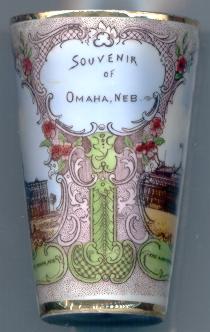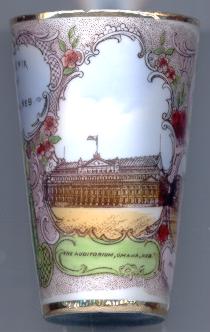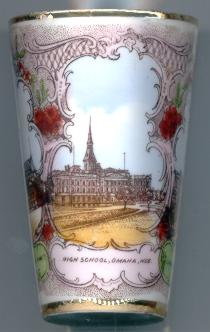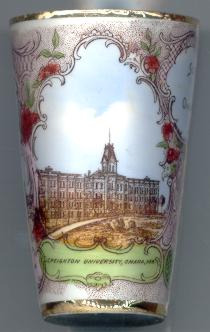

|
| UNITED STATES OF AMERICA | |
| NEBRASKA | |
| Douglas County |
 The name Omaha, according to Indian legend, means "above all others upon a stream". The stream, in this case, is the Missouri river.
A first trading post was established was set up in 1825 within the present city limits of Omaha. A ferry company
operating between Iowa on the eastern bank of the river and the new territory of Nebraska on the western bank founded the town in 1854.
The foundation of the new town was announced in the first issue of the Omaha Arrow newspaper on July 28 of that year.
In 1855 the seat of the territorial givernment of Nebraska was officially located in Omaha.
However, as the wide Platte River was a great obstacle for people living south of that river (the "South Platters") to reach Omaha, their senators voted to move the capital
as far west as possible. The village of Lancaster was chosen for that purpose and was to be renamed "Capitol City". In an attempt to defeat this vote, the Omaha senator
suggested to rename Lancaster "Lincoln" after Abraham Lincoln (1809–1865), 16th President (1861–1865) of the United States, knowing that the South Platters were supporters of the Confederate South.
However, the plan did not work, and Lancaster, from then on Lincoln, became the new capital the same time as Nebraska became a state, on March 1, 1867.
The name Omaha, according to Indian legend, means "above all others upon a stream". The stream, in this case, is the Missouri river.
A first trading post was established was set up in 1825 within the present city limits of Omaha. A ferry company
operating between Iowa on the eastern bank of the river and the new territory of Nebraska on the western bank founded the town in 1854.
The foundation of the new town was announced in the first issue of the Omaha Arrow newspaper on July 28 of that year.
In 1855 the seat of the territorial givernment of Nebraska was officially located in Omaha.
However, as the wide Platte River was a great obstacle for people living south of that river (the "South Platters") to reach Omaha, their senators voted to move the capital
as far west as possible. The village of Lancaster was chosen for that purpose and was to be renamed "Capitol City". In an attempt to defeat this vote, the Omaha senator
suggested to rename Lancaster "Lincoln" after Abraham Lincoln (1809–1865), 16th President (1861–1865) of the United States, knowing that the South Platters were supporters of the Confederate South.
However, the plan did not work, and Lancaster, from then on Lincoln, became the new capital the same time as Nebraska became a state, on March 1, 1867.
The city of Omaha grew rapidly after the eastern terminus of the first transcontinental railway line, the Union Pacific Railroad, was placed here in 1863 by order of President Lincoln.
Union Pacific Railroads still have their headquarters here today. The first telegraph wires establishing fast commnications with the West also started here and were
established by the Western Union Telegraph Co. under the guidance of Edward Creighton (for whom Omaha's Creighton University was named later). Another company worked eastward from
California, eventually linking the Pacific and Atlantic Coasts in 1861. Omaha Barracks were set up in 1868 for the protection of settlers and railroad workers, and
were declared as Fort Omaha in 1878. During World War II, the B-26 and B-29 bombers were produced here, including the "Enola Gay", which dropped the atomic bomb
on Hiroshima on August 6, 1945, and the "Bock's Car", which dropped the bomb on Nagasaki three days later. Today, Omaha is a thriving metropolitan city in the heart of the Midwest.

The old  Omaha Auditorium [right], once located at 15th and Howard Streets, was built in 1904.
The building (164 ft long, 134 ft wide) was built of brick, stone and steel, and was covered with tiles.
It seating capacity was 7,500. The money for the construction ($200,000) and the ground on which it was placed ($55,000) was raised by a
stock company (the Omaha Auditorium Company). Already by 1919 the building had deteriorated so that it even was felt a 'public disgrace'.
The old auditorium was finally demolished in 1963 to make way for a parking lot.
The present Omaha Civic Auditorium, located on 18th and Capitol Streets, was opened in 1954 and was reopened adapted for hockey in 1997.
Omaha Auditorium [right], once located at 15th and Howard Streets, was built in 1904.
The building (164 ft long, 134 ft wide) was built of brick, stone and steel, and was covered with tiles.
It seating capacity was 7,500. The money for the construction ($200,000) and the ground on which it was placed ($55,000) was raised by a
stock company (the Omaha Auditorium Company). Already by 1919 the building had deteriorated so that it even was felt a 'public disgrace'.
The old auditorium was finally demolished in 1963 to make way for a parking lot.
The present Omaha Civic Auditorium, located on 18th and Capitol Streets, was opened in 1954 and was reopened adapted for hockey in 1997.

 Omaha High School [left], today called Central High School, was founded in 1859 and was Omaha's first
all-grades public school. An actual own building for the school did not exist for 12 years. In 1869 the Nebraska Legislature donated its old Capitol Building. This building,
however, could not be used as it was declared unsafe. In its place a new high school building was erected in 1870/1871. Its 150 ft (46 m) spire was a popular
vantage point that offered a good view of Omaha city. In 1876 the spire was used for the first demonstration of electric lights in Omaha. All important visitors were given a tour
of Omaha High School, among them, in 1911, William Howard Taft (1857–1930), 27th President (1909–1913) of the United States. The construction of the present-day building was started in 1900.
Until 1912, the new school was built wing by wing around the old structure. For the construction of the last (north) wing the remaining parts of the old school including the spire
had to be torn down. The picture on the tumbler [see left] shows the new school building with the old spire in the background, so the tumbler seems to date from around 1911.
Gym buildings were added to the school in 1925 and 1977. An extensive renovation of the building in 1981/82 also included the construction of a translucent dome
enclosing the central courtyard.
Omaha High School [left], today called Central High School, was founded in 1859 and was Omaha's first
all-grades public school. An actual own building for the school did not exist for 12 years. In 1869 the Nebraska Legislature donated its old Capitol Building. This building,
however, could not be used as it was declared unsafe. In its place a new high school building was erected in 1870/1871. Its 150 ft (46 m) spire was a popular
vantage point that offered a good view of Omaha city. In 1876 the spire was used for the first demonstration of electric lights in Omaha. All important visitors were given a tour
of Omaha High School, among them, in 1911, William Howard Taft (1857–1930), 27th President (1909–1913) of the United States. The construction of the present-day building was started in 1900.
Until 1912, the new school was built wing by wing around the old structure. For the construction of the last (north) wing the remaining parts of the old school including the spire
had to be torn down. The picture on the tumbler [see left] shows the new school building with the old spire in the background, so the tumbler seems to date from around 1911.
Gym buildings were added to the school in 1925 and 1977. An extensive renovation of the building in 1981/82 also included the construction of a translucent dome
enclosing the central courtyard.

The history of  Creighton University [right] goes back to an idea of Edward Creighton who was responsible for the laying of the
transcontinental telegraph lines from Omaha to the west coast. Creighton died in 1874, and his widow, Mary Lucretia Creighton, who inherited his fortune, included
the sum of $ 100,000 in her will for the purpose of establishing a school in memory of her husband. She also specifically directed that this school be "of the class and grade of a college",
located "in the city of Omaha", and known as "Creighton University". After her death, her brother-in-law, John A. Creighton, used the money to purchase land and to build the first school building.
these were transferred to the Rt. Rev. James O'Connor, Bishop of Omaha, in 1878, who asked the Jesuites to operate the school. In 1879 the trust was surrendered to
a new corporation, "The Creighton University". John Creighton later was honoured by Pope Leo XIII with the order of St. Gregory and later
received the title of a Count of the Papal States. The picture on the tumbler shows the old administration building of 1878, which was replaced in 1920/29 by the
present-day construction built by architect Leo A. Daly.
Creighton University [right] goes back to an idea of Edward Creighton who was responsible for the laying of the
transcontinental telegraph lines from Omaha to the west coast. Creighton died in 1874, and his widow, Mary Lucretia Creighton, who inherited his fortune, included
the sum of $ 100,000 in her will for the purpose of establishing a school in memory of her husband. She also specifically directed that this school be "of the class and grade of a college",
located "in the city of Omaha", and known as "Creighton University". After her death, her brother-in-law, John A. Creighton, used the money to purchase land and to build the first school building.
these were transferred to the Rt. Rev. James O'Connor, Bishop of Omaha, in 1878, who asked the Jesuites to operate the school. In 1879 the trust was surrendered to
a new corporation, "The Creighton University". John Creighton later was honoured by Pope Leo XIII with the order of St. Gregory and later
received the title of a Count of the Papal States. The picture on the tumbler shows the old administration building of 1878, which was replaced in 1920/29 by the
present-day construction built by architect Leo A. Daly.
![[scale]](lineal.jpg)